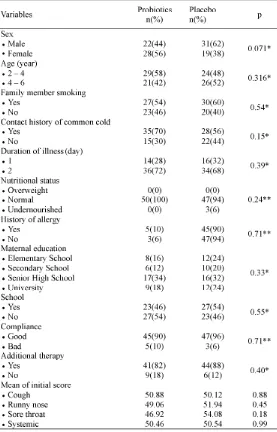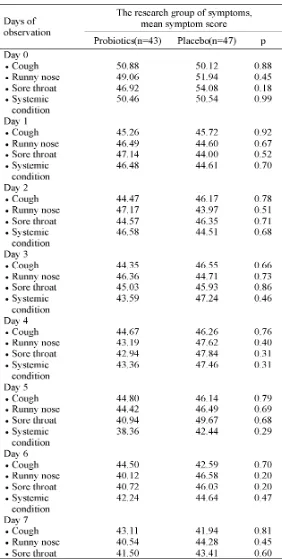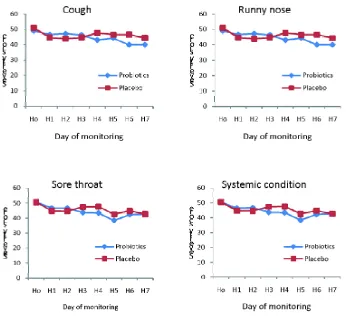* corresponding author: drekasarie@gmail.com
The effects of
Lactobacillus acidophilus
and
Lactobacillus rhamnosus
on clinical
improvement of common cold in children
Eka Sari Astuti*, Sumadiono, Amalia Setyati
Department of Pediatrics, Faculty of Medicine, Universitas Gadjah Mada/Dr. Sardjito Hospital, Yogyakarta
ABSTRACT
Children get an average of six common colds per year and irrational antibiotic has been prescribed to 60% of the cases that potentially cause antibiotic resistency. Studies in humans show that probiotics are effective in reducing the severity of common cold symptoms. Probiotics are attributed to an increase of the innate and acquired immune response against the common colds. The study aimed to investigate whether the consumption of Lactobacillus acidophilus R0052 and L. rhamnosus R0011 influenced the severity of symptoms of the common cold in children. This was a clinical study using a double blind randomized placebo controlled trial design involving 100 children who developed symptoms of the common cold within 24-48 hours before enrollment. Patients in the Probiotics Group (n=50) received probiotics capsules containing a combination ofL.acidophilusandL. rhamnosusonce perday for 7 days. Patients in the Placebo Group (n=50) received similarly administered capsules containing saccharum lactis. Subjective daily symptom scores for cough, nasal, pharyngeal and systemic symptoms were used as main outcomes. The results showed that the daily mean symptom score during an episode was not significantly different in the Probiotics Group compared the Placebo Group (p>0.05). There was also no significant relative risk reduction in the number of improvement from severity symptoms score of common cold in both of groups (unadjusted absolute % reduction 0, p=1). Moreover, there was no report of adverse events in the Probiotic and Placebo Groups. In conclusion, L. acidophilusR005 and L. rhamnosus R0011 in the form and dosage studied do not significantly reduce the severity of symptoms of the common cold in children.
ABSTRAK
dan plasebo. Sebagai kesimpulan, L. acidophilus R005 danL. rhamnosus R0011 dengan dosis yang digunakan dalam penelitian ini tidak terbukti dapat mengurangi gejala flu pada anak.
Keywords: common cold-children - probiotics -Lactobacillus acidophilus -L.rhamnosus- clinical trial
INTRODUCTION
Common cold is a viral infection of the upper respiratory tract characterized by symptoms of cough and cold. The most commonly infecting viruses are rhinovirus, coronavirus, influenza viruses, adenoviruses and parainfluenza viruses. Common cold is a self-limited disease that can heal themselves.1
Prevalence of common cold in Indonesia in children is three to six times. Common cold is one of the main causes of patient visit at health facilities in Indonesia, accounting 40%-60% of visit for treatment at health care centers and 15% -30% of visits at the outpatient treatment.2
Common cold significantly affects the health and comfort of the patients as it requires substantial medical costs and an economic burden.3
Irrational prescribing of antibiotics has been reported in 60% of cases of upper respi-ratory infection.4This is an important issue in
health, as it can cause resistance to antibiotics. Meanwhile, the symptomatic treatment based on the latest from the Cochrane review is not effective.5
There have been many experimental data to support the hypothesis that probiotics may provide a beneficial effect on infectious diseases by immunomodulatory immune system.6Probiotics enhance the immune system,
both locally and systemically7,8which can be
potentially relevant with the immunomodulatory effects to overcome the common cold infection. However,the scientific evidence on this subject is still very limited. Therefore, clinical studies to obtain the scientific evidence are needed. This study was conducted to evaluate the effect
of probiotics administration (L.acidophilus R0052 andL. rhamnosusR0011) on the clinical improvement of common cold in children.
MATERIALS AND METHODS
Study design
This was a clinical study using a double-blind randomized placebo controlled trial design to evaluate the effect ofL. acidophilus R0052 and L. rhamnosus R0011 on clinical improvement of common cold in children. Subjects were assigned randomly using a computer program to receive probiotics or placebo. The study protocol has been approved by the Medical and Health Research Ethical Committee of Faculty of Medicine, Universitas Gadjah Mada, Yogyakarta. Written informed consents were obtained from parents of all subjects.
Subjects
Target population in this study were children aged 2-6 years who suffered from common cold, while the accessible population in this study were children with the common cold who were brought by their parents to Primary Health Care Center (Pusat Kesehat-an Masyarakat = Puskesmas) Kesehat-and met the inclusion and exclusion criteria.
The inclusion criteria referred to children who suffered from common cold according to American Academy of Pediatrics criteria (2006) which includes runny nose, sneezing, mild fever (<39oC), decreases appetite, sore throat, cough,
related diseases during physical examination. Children were excluded from the study if they were currently having symptoms of an acute otitis media, symptoms of an acute sinusitis, symptoms of lower respiratory diseases, history of acute or chronic diarrhea and suffered from common cold more than two days.
Sample size
Sample size for each group was calculated with Lemeshow formula. Based on previous studies, it is assumed that the proportion of the treatment group had improved the clinical symptoms by 60% and in the Placebo Group by
27.5%.9Therefore, the minimum sample size in
order to estimate the clinical improvement of commom cold for each group of treatment was 38.
Probiotics preparation
Probiotics or placebo preparation were provided as dry powders packaged into capsules. The probiotics preparation consisted of a combination of L.acidophilus R0052 at concentration of 0.1x109colony-forming units
(CFUs) per g and L. rhamnosusR0011 at concentration of 1.9x109CFUs per g. The
placebo preparation was composed entirely of saccharum lactis. The preparations were made in Hospital Pharmacy Installation of Dr. Sardjito General Hospital, Yogyakarta. All preparations were distributed and stored refrigerated at the study site until the time of use.
Protocol of study
The study was conducted within the study period of November 2011 to January 2012.Two Puskesmas in Bantul District, Yogyakarta Special Region i.e, Puskesmasof Jetis 2 and Puskesmasof Sewon 2 were used as the study site. Subjects suspected of common cold underwent anamnesis and clinical examination
conducted by physicians of thePuskesmasand were gathered to be selected. An explanation concerning the background, objectives, benefit of the study was given during the selection. The characteristics of subjects who met the inclusion and exclusion criteria were taken and an informed consent was given to the parents to be signed. Subjects were then randomly allocated into Probiotics Group or Placebo Group and were administered once per day for 7 days.The effects of the Probiotics and Placebo Pre-parations on clinical improvement of common cold were monitored by research assistants daily during 7 days based on a severity of illness score proposed by Hemilä and Douglas.10
Statistical and data analyses
During the study, research assistants monitored and recorded symptoms severity score of the common cold consisting scores of cough, colds, sore throat and systemic conditions. Summary of statistics consisting off requencies and proportions were generated for categorical variables (e.g. sex, family number smoking, contact history of common cold). Continous variables (e.g. severity score of cough, colds, sore throat and systemic conditions) were shown by using mean. Univariate analysis was performed to evaluate the characteristics of the subjects, while bivariate analysis using Chi square (X2) and
RESULTS
A total of 100 children suffering from common cold were involved in this study. Subjects were randomized using a computer program to be grouped in either probiotics or placebo groups, with 50 children included in each group. TABLE 1 presents the characteristics of subjects among the two study groups. The characteristics of subjects in the two groups were balanced as indicated with the absence of significant
difference in the characteristics of subjects between the Probiotics and Placebo Groups.The severity score of common cold in the Probiotics Group was not significantly different compared to the Placebo Group. Eight subjects in the Probiotics Group and five subjects in Placebo Group were lostin follow-up at seventh day of observation. However, the number of subjects who dropped out during the study did not affect the minimal sample size needed in the study.
TABLE 1. Basic characteristics of research subjects
The severity score of common cold symptoms namely cough, cold, sore throat and systemic conditions from firstday to seventh day
TABLE 2. The effects of probiotics on symptoms severity score of common cold observation for 7 days
Figure 1. The daily severity score of common cold symptoms in Probiotics and Placebo Groups for 7 days of monitoring
To evaluate the effects of probiotics administration on clinical improvement of common cold, the severity score of the symptoms of both groups at day 7 was determined and compared to base line at day 0 in both groups. On the seventh day of monitoring, the clinical improvement was observed on 11 patients (22%) in the Probiotics Group as well as in Placebo Group (TABLE 3). The total severity score of common cold at the seventh day of monitoring in both groups was similar. The RRR in symptoms severity score of the common cold in the Probiotics Groups, compared to the Placebo Group was 0/78% = 0%. It indicated that the administration of a combination of probiotics consisting ofL. acidophilusR0052 and L. rhamnosus R0011 did not have a significant effect on clinical improvement of
common cold in children. Moreover, no side effects due to the probiotics administration was reported during the study.
TABLE 3. Cross table of clinical improvementof
common cold symptoms in the
Probiotics and the Placebo Groups
DISCUSSION
Probiotics administration in this study was not found to reduce the severity score of cough, cold, sore throat and systemic conditions compared with Placebo group from first day to seventh day monitoring. This result was found to be incontrary to the previous studies.
Probiotics have been investigated widely for health benefits in different disease conditions, especially common colds. de Vreseet al.11,12reported that the administration
of a combination of three strains of probiotics (L. gasseri PA 16/8, Bifidobacterium longum SP 07/3 dan B. bifidum MF 20/5) can reduce duration and severity but not the incidence of common cold episodes. Other study showed that L. acidophilus NCFM or a combination L. acidophilusNCFM andB. animaliscan reduce the incidence and the symptoms of common colds in children.13It has also been mentioned
that the combination of probiotics, vitamins and mineral can reduce duration and severity of common colds through the increase of cellular immune parameters.14
Pre clinical and clinical studies have demonstrated that probiotics are effective against viral infection. However, the underlying mechanisms by which probiotics work are not completely understood. The possible antiviral mechanisms of probiotics include the competitive inhibition of virus attachment to the host cell receptor,15,16production of metabolites and
substances with direct antiviral activities,17-19and
stimulation of nonspecific and specific immune responses to viral infections.20-23
The effectiveness of probiotics can be influenced by various factors such as viability of probiotics and hosts conditions. Probiotics can be effective only if it remains viable until it reaches its destination in the intestine and initiates an immune response. Resistance to gastric acid is an important requirement of probiotics. Gastric acid has a pH of about 2.5, consisting of water (97-99%) mucin (mucus),
inorganic salts, and digestive enzymes. The time required to start when bacteria get out of the hull is about 90 minutes. Once the bacteria are successfully through the stomach, they will enter the upper intestinal tract where bile salts are secreted. After traveling through a difficult environment, probiotics bacteria should survive from the bile salts in the duodenum and then colonize in the low intestinal tract.24The time
required to empty of the small intestine is about 4-5 hours.25In addition, the viability of
probiotics depends on the storage conditions. Probiotics will be degraded by heat, light, humidity and oxygen during the storage.26
The effectiveness of probiotics may also be influenced by various host conditions such as nutritional status, physiological condition, as well as immune system. Nutritional status is associated with a significant impairment of cell-mediated immunity, phagocyte function, immuno-globulin A concentrations and cytokine pro-duction that can change the effectiveness of a dietery supplement of probiotics on respiratory tract diseases in children.27-29Moreover, the
different physiological conditions during lifespan such as gestation, infancy, childhood, adolescence, young adulthood, adulhood and old age influence the immune system that can influence the effectiveness of the probiotics.30
Additionally, the effectiveness of probiotics in the treatment and prevention of viral infections is influenced by the dose and duration of administrations and the strain to strain variations. A commonly held assumption is that higher doses of probiotics given for short courses are more effective than lower doses at ameliorating viral infections. However, the dose effects of probiotics on ameliorating the viral infections remain controversial.30-32A review
CONCLUSION
In conclusion, the administration of a probiotics combination ofL. acidophilusR0052 at concentration of 0.1x109CFU sper g andL.
rhamnosusR0011 at concentration of 1.9x109
CFUs per g once daily for 7 days does not improve the clinical outcome of common cold in children aged two to six years. The severity score of common cold symptoms of children who were given the probiotics is not signi-ficantly different compared to the placebo group.
ACKNOWLEDGEMENTS
The authors would like to thank all subjects and their parents who participated in this study.
REFERENCES
1. Virk A. Upper respiratory tract infection, current medical diagnosis and treatment. New York: McGraw-Hill Proffessional. 2001.
2. Depkes RI. Pedoman pemberantasan penyakit infeksi saluran pernapasan akut pada balita. Jakarta: Depkes RI; 2004.
3. Barrett BP, Brown RL, Locken K, Maberry R, Bobula JA, D’Alessio D. Treatment of the common cold with unrefined echinacea.A randomized, double-blind, placebo-controlled trial. Ann Intern Med. 2002; 137(32):939-46.
4. Mainous AG, Hueston WJ, Clark JR. Antibiotics and upper respiratory infection: do some folks think there is a cure for the common cold. J Fam Pract. 1996; 42(4):357-61.
5. Arroll B. Non-antibiotic treatments for upper-respiratory tract infections (common cold). Respir Med. 2005; 99(12):1477-84.
6. Gueimonde M, Salminen S. New methods for selecting and evaluating probiotics. Dig Liver Dis. 2006; 38(suppl 2):S242-47.
7. Erickson KL, Hubbard NE. Probiotics immuno-modulation in health and disease. J Nutr. 2000; 130(2S Suppl):403-9.
8. Schultz M, Linde HJ, Lehn N, Zimmermann K, Grossmann J, Falk W. Immunomodulatory consequences of oral administration of
Lactobacillus rhamnosus strain GG in healthy volunteers. J Dairy Res. 2003;70:165-73.
9 Munasir Z. The role of phyllanti herba in the treatment of upper respiratory tract infections in pediatric patients. Clinical research Division of Dexa Medica Pharmaceutical. Jakarta: 2003. 10. Hemilä H, Douglas RM. Vitamin C and acute
respiratory infections. Int J Tuberc Lung Dis. 1999; 3(9):756-61.
11. de Vrese M, Winkler P, Rautenberg P. Effect of
Lactobacillus gasseri PA 16/8, Bifidobacterium longumSP 07/3,B bifidumMF 20/5 on common cold episodes: a double blind, randomized, controlled trial. Clin Nutr. 2005; 24(4):481– 91. 12. de Vrese M, Winkler P, Rautenberg P. Probiotics bacteria reduced duration and severity but not the incidence of common cold episodes in a double blind, randomized, controlled trial. Vaccine.2006; 24(44–46):6670–4.
13. Leyer, G.J., Li, S., Mubasher, M.E., Reifer, C., Ouwehand, A.C. 2009. Probiotics effects on cold and influenza-like symptom incidence and duration in children. Pediatrics. 124(2):e172-9.
14. Winkler P, de Vrese M, Laue C, Schrezenmeir J. Effect of a dietary supplement containing probiotics bacteria plus vitamins and minerals on common cold infections and cellular immune parameters. Int J Clin Pharmacol Ther. 2005; 43(7):318 –26.
15. Salminen S, Nybom S, Meriluoto J, Carmen Collado M, Vesterlund S, El-Nezami H. Interaction of probiotics and pathogens-benefits to human health? Curr Opin Biotechnol. 2010;21:157-67.
16. Botiæ T, Klingberg TD, Weingartl H, Cenciè A. A novel eukaryotic cell culture model to study antiviral activity of potential probiotics bacteria. Int J Food Microbiol. 2007;115:227-34. 17. Ivec M, Botic T, Koren S, Jakobsen M, Weingartl
H, Cencic A. Interactions of macrophages with probiotics bacteria lead to increased antiviral response against vesicular stomatitis virus. Antiviral Res. 2007;75:266-74.
18. Servin AL. Antagonistic activities of Lactobacilli and Bifidobacteria against microbial pathogens. FEMS Microbiol Rev. 2004;28:405-40.
19. Xu WL, Zheng S, Dweik RA, Erzurum SC. Role of epithelial nitric oxide in airway viral infection. Free Radic Biol Med. 2006;41:19-28.
21. O’Hara AM, O’Regan P, Fanning A, O’Mahony C, MacSharry J, Lyons A, Bienenstock J, O’Mahony L, Shanahan F. Functional modulation of human intestinal epithelial cell responses by
Bifidobacterium infantis and Lactobacillus salivarius. Immunology. 2006;118:202-15. 22. Latvala S, Miettinen M, Kekkonen R, Korpela R,
Julkunen I. Potentially probiotics bacteria induce cytokine production and suppressor of cytokine signaling 3 gene expression in human monocyte-derived macrophages. Cytokine. 2009;48:100-1. 23. Cox AJ, Pyne DB, Sauders PU, Fricker PA. Oral administration of the probiotics Lactobacillus fermentum VRI-003 and mucosal immunity in endurance athletes. Br J Sports Med. 2010; 44(4):222-6.
24. Latvala S, Miettinen M, Kekkonen R, Korpela R, Julkunen I. Potentially probiotics bacteria induce cytokine production and suppressor of cytokine signaling 3 gene expression in human monocyte-derived macrophages. Cytokine. 2009;48:100-101.
25. Berrada N, Lemeland JF, Laroche G, Thouvenot P, Piaia M. Bifidobacterium from fermented milks: survival during gastric transit. J Dairy Sci. 1991; 74(2):409-13.
26. Rowen RJ. The effect of probiotics and mucoprotective agents on PPI-based triple therapy for eradication of Helicobacter pylori. Helico-bacter. 2010; 15(3):206-13.
27. Lahteenmaki L, Ledeboer AM. Probiotics - the consumer perspective. Food SciTechnol Bull. 2006; 3(5):47-50.
28. Solis B, Samartín S, Gómez S, Nova E, de la Rosa B, and Marcos A. Probiotics as a help in children suffering from malnutrition and diarrhoea. EJCN. 2002;56(Suppl):S57-9.
29. Río ME, Zago Beatriz L, Garcia H, Winter L. The nutritional status change the effectiveness of a dietary supplement of lactic bacteria on the emerging of respiratory tract diseases in children. Arch Latinoam Nutr. 2002; 52(1):29-34. 30. Nova E, Wärnberg J, Gómez-Martínez S, Díaz LE,
RomeoJ, Marcos A. Immunomodulatory effects of probiotics in different stages of life. Br J Nutr. 2007;98(Suppl. 1):S90-5.
31. Salazar-Lindo E, Miranda-Langschwager P, Campos-Sanchez M, Chea-Woo E, Sack RB.
Lactobacillus caseistrain GG in the treatment of infants with acute watery diarrhoea: a randomized, double-blind, placebo controlled clinical trial [ISRCTN67363048]. BMC Pediatr 2004; 4(18): doi: 10.1186/1471-2431-4-18.
32. Basu S, Paul DK, Ganguly S, Chatterjee M, Chandra PK. Efficacy of high-doseLactobacillus rhamnosus GG in controlling acute watery diarrhoea in Indian children: a randomized controlled trial. J Clin Gastroenterol. 2009; 43: 208–13.


